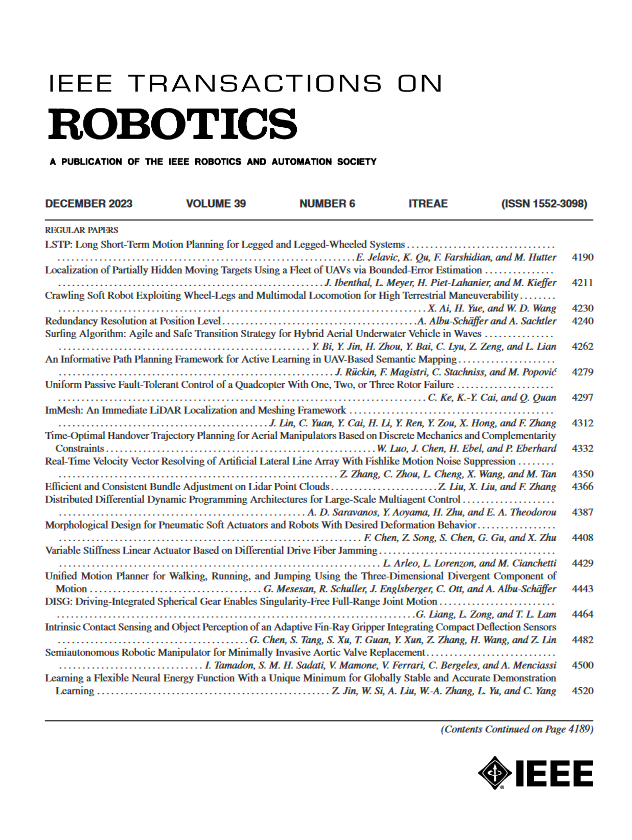运动规划扩散:用扩散模型学习和适应机器人运动规划
IF 10.5
1区 计算机科学
Q1 ROBOTICS
引用次数: 0
摘要
基于优化的机器人运动规划算法的性能高度依赖于初始解,通常通过运行基于采样的规划器来获得无碰撞路径。然而,这些方法在高维和复杂的场景中速度很慢,并且产生不光滑的解。给定先前解决的路径规划问题,学习它们的分布并将其用作新的类似问题的先验是非常可取的。一些工作建议在引导运动规划问题之前利用它,或者通过从中采样初始解,或者使用其分布在最大后验公式中进行轨迹优化。在这项工作中,我们引入了运动规划扩散(MPD),这是一种使用扩散模型学习轨迹分布先验的算法。这些生成模型在编码多模态数据方面显示出越来越大的成功,并且具有基于梯度的运动规划的理想特性,例如成本指导。给定一个运动规划问题,在去噪过程中,我们利用学习到的先验和代价函数梯度从后验分布中构造代价函数和样本。我们建议使用线性运动原语,特别是b样条曲线来学习较低维度的轨迹表示,而不是在所有轨迹路径点上学习先验。这种参数化保证了生成的轨迹是平滑的,可以在更高的频率上插值,并且比密集的路点表示需要更少的参数。我们展示了我们的方法的结果,从简单的2-D到更复杂的任务,使用7-DOF机械臂机械手。除了从模拟数据中学习外,我们还在现实世界的拾取任务中使用人类演示。实验结果表明,在基于优化的运动规划中,扩散模型是编码多模态轨迹分布的强先验。本文章由计算机程序翻译,如有差异,请以英文原文为准。
Motion Planning Diffusion: Learning and Adapting Robot Motion Planning With Diffusion Models
The performance of optimization-based robot motion planning algorithms is highly dependent on the initial solutions, commonly obtained by running a sampling-based planner to obtain a collision-free path. However, these methods can be slow in high-dimensional and complex scenes and produce nonsmooth solutions. Given previously solved path-planning problems, it is highly desirable to learn their distribution and use it as a prior for new similar problems. Several works propose utilizing this prior to bootstrap the motion planning problem, either by sampling initial solutions from it, or using its distribution in a maximum-a-posterior formulation for trajectory optimization. In this work, we introduce motion planning diffusion (MPD), an algorithm that learns trajectory distribution priors with diffusion models. These generative models have shown increasing success in encoding multimodal data and have desirable properties for gradient-based motion planning, such as cost guidance. Given a motion planning problem, we construct a cost function and sample from the posterior distribution using the learned prior combined with the cost function gradients during the denoising process. Instead of learning the prior on all trajectory waypoints, we propose learning a lower dimensional representation of a trajectory using linear motion primitives, particularly B-spline curves. This parametrization guarantees that the generated trajectory is smooth, can be interpolated at higher frequencies, and needs fewer parameters than a dense waypoint representation. We demonstrate the results of our method ranging from simple 2-D to more complex tasks using a 7-DOF robot arm manipulator. In addition to learning from simulated data, we also use human demonstrations on a real-world pick-and-place task. The experiment results show that diffusion models are strong priors for encoding multimodal trajectory distributions for optimization-based motion planning.
求助全文
通过发布文献求助,成功后即可免费获取论文全文。
去求助
来源期刊

IEEE Transactions on Robotics
工程技术-机器人学
CiteScore
14.90
自引率
5.10%
发文量
259
审稿时长
6.0 months
期刊介绍:
The IEEE Transactions on Robotics (T-RO) is dedicated to publishing fundamental papers covering all facets of robotics, drawing on interdisciplinary approaches from computer science, control systems, electrical engineering, mathematics, mechanical engineering, and beyond. From industrial applications to service and personal assistants, surgical operations to space, underwater, and remote exploration, robots and intelligent machines play pivotal roles across various domains, including entertainment, safety, search and rescue, military applications, agriculture, and intelligent vehicles.
Special emphasis is placed on intelligent machines and systems designed for unstructured environments, where a significant portion of the environment remains unknown and beyond direct sensing or control.
 求助内容:
求助内容: 应助结果提醒方式:
应助结果提醒方式:


